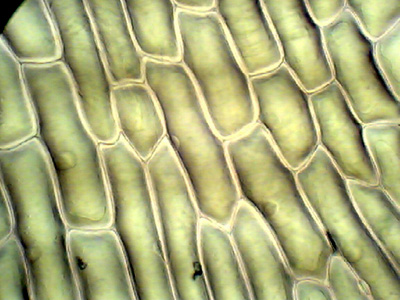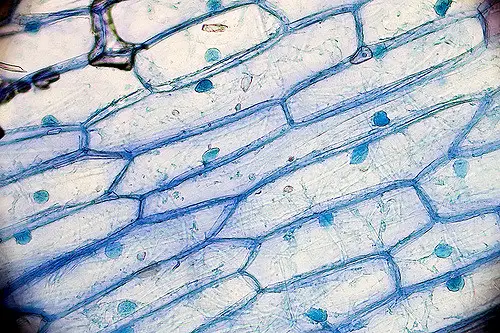Onion Cells Under a Microscope
** Requirements, Preparation and Observation
The bulb of an onion is formed from modified leaves. While photosynthesis takes place in the leaves of an onion containing chloroplast, the little glucose that is produced from this process is converted in to starch (starch granules) and stored in the bulb.
Chlorophyll and chloroplasts responsible for photosynthesis are therefore only present in the leafy part of the onion (above ground) and absent in the bulb (which grows below ground).
Unlike animal cells (such as cheek cells) the cell wall of an onion and other plants are made up of cellulose, which protects the cell and maintains its shape.
How to Obtain a Thin Layer of Onion Cells
An onion is made up of layers that are separated by a thin membrane. For this experiment, the thin membrane will be used to observe the onion cells. It can easily be obtained by peeling it from any layer of the onion using tweezers.
How to Prepare a Wet Mount Slide
- A thin onion membrane,
- Microscopic glass slides,
- Microscopic cover slips,
- A needle,
- Blotting paper,
- Dropper,
- Iodine Solution,
- Water,
- Microscope
**Note- In microscopy, wet mount refers to a glass slide holding a specimen suspended on a drop of liquid for examination.
Moreover, to avoid breaking the slide and damage to the microscope objective lenses during observation, it's important that the optical tube be lowered to the point that the objective lens is as close to the slide as possible.
This should be done starting with low power while looking from the side of the microscope rather than through the eye piece. From this point, it becomes easier to focus for clarity without any accidents.
- Add a drop of water at the center of the microscopic slide
- Having pulled of a thin membrane from the onion layer, lay it at the center of the microscopic slide (the drop of water will help flatten the membrane)
- Add a drop of iodine solution on the onion membrane (or methylene blue)
- Gently lay a microscopic cover slip on the membrane and press it down gently using a needle to remove air bubbles.
- Touch a blotting paper on one side of the slide to drain excess iodine/water solution,
- Place the slide on the microscope stage under low power to observe.
- Adjust focus for clarity to observe.
Students can make another slide without adding the stain to see the difference between a stained slide and a non-stained slide.
Observations
- Large, rectangular interlocking cells,
- Clearly visible distinct cell walls surrounding the cells,
- Dark stained nucleus,
- Large vacuoles at the center,
- Small granules may be observed inside the cells (within the cytoplasm)
The layers of an onion contain simple sugars (carbohydrates) some of which are stored as starch (starch granules). Given that iodine tends to bind to starch, it stains the starch granules when the two come in to contact making them visible.
Although onions may not have as much starch as potato and other plants, the stain (iodine) allows for the little starch molecules to be visible under the microscope. Although onions are plants, students will not see any chloroplasts in their slides.
This is because of the fact that the chloroplast necessary for photosynthesis is largely present in the leafy part of the onion, which is exposed to the sun and absent in the bulb which is below ground and away from sunlight.
Unlike animal cells, students will also notice that the plant cells have a more regular shape. This is because they have a cell wall made up of cellulose which maintains its shape.
Conclusion
This is an easy and fun activity that will allow the student to learn about the cell structure. Students have the opportunity to experiment and observe the onion membrane with different stains (methylene blue and iodine) and without the stain and observe the differences.
Having observed the onion cell under the microscope, students will be able to learn the differences between animal and plant cells in addition to the function of the different parts of the cell.
Learn about Onion Root Tip Mitosis
Check out other microscope experiment viewing Cheek Cells, Cork Cells or Sugar Crystals as well and have fun looking at Leaf Structure under the Microscope!
Return to Microscope Experiments
Return to MicroscopeMaster Home
Find out how to advertise on MicroscopeMaster!






